
Hypena is a genus of moths in the family Erebidae. It was first described by Franz von Paula Schrank in 1802. These non-migratory moths overwinter as pupae and almost never estivate as adults.
Cryptobotys is a monotypic moth genus of the family Crambidae described by Eugene G. Munroe in 1956. Its only species, Cryptobotys zoilusalis, was described by Francis Walker in 1859. It is found in Cuba, Jamaica, Puerto Rico, Central America and the southern United States, where it has been recorded from Florida.
Maracayia chlorisalis is a moth of the family Crambidae described by Francis Walker in 1859. It is found from North America through Costa Rica south at least to Brazil.

Zanclognatha is a genus of litter moths of the family Erebidae. The genus was erected by Julius Lederer in 1857.

Phytometra is a genus of moths of the family Erebidae. The genus was described by Adrian Hardy Haworth in 1809.
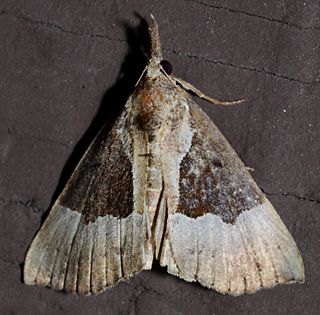
Hypena bijugalis, the dimorphic bomolocha, dimorphic hypena or toothed snout-moth, is a moth of the family Erebidae. The species was first described by Francis Walker in 1859. It is found in North America from Nova Scotia across southern Canada to Vancouver Island, south over the whole United States to Florida.
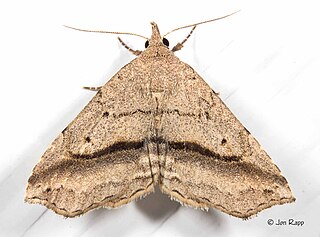
Ledaea perditalis, the buttonbush owlet or lost owlet moth, is a moth in the family Erebidae. The species was first described by Francis Walker in 1859. It is found in North America from the Great Lakes states, Quebec and northern New England, south to Florida and Texas.

Phalaenostola eumelusalis, the punctuated owlet or dark phalaenostola, is a moth of the family Erebidae. The species was first described by Francis Walker in 1859. It is found in North America from New Brunswick, North Dakota and South Dakota to Maine, south to Georgia and Iowa. In the north it is also found in Saskatchewan.
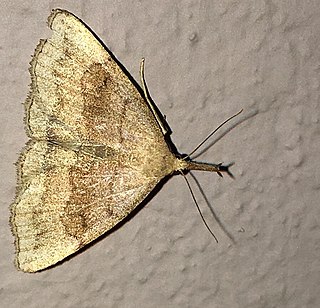
Phalaenostola metonalis, the pale phalaenostola, tufted snout or pale epidelta, is a moth of the family Erebidae. The species was first described by Francis Walker in 1859. It is found in North America from British Columbia to Newfoundland, south to North Carolina, west to Missouri.

Renia sobrialis, the sober renia, is a litter moth of the family Erebidae. The species was first described by Francis Walker in 1859. It is found from Nova Scotia to Florida, west to Mississippi and Minnesota.
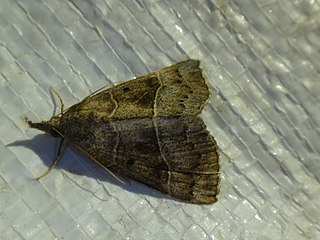
Hypena deceptalis, the deceptive hypena or deceptive bomolocha moth, is a moth of the family Erebidae. The species was first described by Francis Walker in 1859. It is found in North America from Manitoba to Quebec, south to Florida and Texas. It is absent from much of Gulf Coastal Plain though.

Hypena abalienalis, the white-lined hypena or white-lined bomolocha moth, is a moth of the family Erebidae. The species was first described by Francis Walker in 1859. It is found from southern Canada to northern Florida and Texas.
Phytometra rhodarialis, the pink-bordered yellow, is a moth of the family Erebidae. The species was first described by Francis Walker in 1859. It is found from southern Ontario in Canada and Missouri and New Hampshire in the United States, south to Florida and Texas in the United States, possibly only as stray northward.
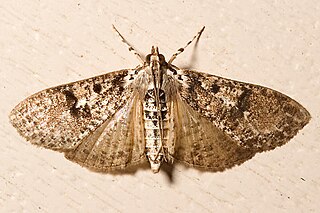
Palpita arsaltealis is a moth of the family Crambidae first described by Francis Walker in 1859. It is found in the north-eastern United States, south to South Carolina. It is also present in Quebec and Ontario.

Glyphodes sibillalis, the mulberry leaftier moth, is a moth of the family Crambidae. It is found in the southern United States, Central and South America and the West Indies.

Banisia myrsusalis, the sapodilla borer or sapota midrib folder, is a species of moth of the family Thyrididae. It was described by Francis Walker in 1859 and is found in North America, Brazil, Australia, southern Asia and Africa.
Sitochroa dasconalis is a moth in the family Crambidae. It was described by Francis Walker in 1859. It is found in North America, where it has been recorded from Massachusetts to Illinois, south to Florida and then west to Texas.

Glyphodes pyloalis, the lesser mulberry snout moth, lesser mulberry pyralid or beautiful glyphodes moth, is a moth in the family Crambidae. It was described by Francis Walker in 1859. It is found in Iran, China, Japan, India, Indonesia (Sumatra), Sri Lanka, Taiwan, the Democratic Republic of the Congo, Equatorial Guinea, Mozambique and North America, where it has been recorded from Florida, Maryland, North Carolina, South Carolina and Virginia.

Zanclognatha theralis, the noctuid moth, is a species of moth native to North America. It was described by Francis Walker in 1859. It is listed as threatened in the US state of Connecticut.
Agroterini is a tribe of the species-rich subfamily Spilomelinae in the pyraloid moth family Crambidae. The tribe was erected by Alexandre Noël Charles Acloque in 1897.















